


September 30, 2010
Volume II, Issue 14
www.303rdBG.com
The Front Half of "Wallaroo Mark II" Flew 81 Missions – The Back Half Flew 110
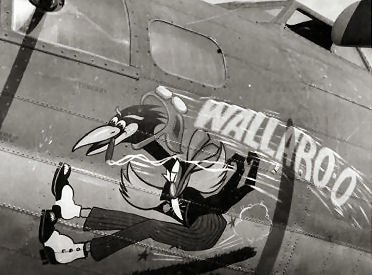 B-17G 42-31405 (BN-X), "Wallaroo Mark II", had a long history with the 359th Bomb Squadron, flying numerous crews on 81 combat missions. She was assigned to the 303rd BG / 359th BS on January 14, 1944. Her first mission was number 100, January 21, 1944, with the 2Lt Vern L. Moncur Crew. Her last was Mission 218, on August 4, 1944 with the 2Lt Maurice V. Altman Crew. The nose art photo to the left is actually the original "Wallaroo" #42-3029. There are no known photos of the nose art of "Wallaroo Mark II." We believe the two were almost identical. If anyone has a photo, we would appreciate a copy.
B-17G 42-31405 (BN-X), "Wallaroo Mark II", had a long history with the 359th Bomb Squadron, flying numerous crews on 81 combat missions. She was assigned to the 303rd BG / 359th BS on January 14, 1944. Her first mission was number 100, January 21, 1944, with the 2Lt Vern L. Moncur Crew. Her last was Mission 218, on August 4, 1944 with the 2Lt Maurice V. Altman Crew. The nose art photo to the left is actually the original "Wallaroo" #42-3029. There are no known photos of the nose art of "Wallaroo Mark II." We believe the two were almost identical. If anyone has a photo, we would appreciate a copy.
On Mission 144 to Berlin, April 29, 1944, 2Lt Homer E. Raker, copilot on the 1Lt Ernest L. Roth Crew was mortally wounded by flak, which also disabled one engine. Lt Roth asked Lt Raker to adjust the engines. Despite being in great pain, he feathered the engine and adjusted the supercharger. He then slumped forward unconscious and died. For his actions 2Lt Raker was posthumously awarded the Silver Star Medal.
On August 7, 1944, on a non-combat flight, "Wallaroo Mark II" crash-landed at the RAF base at Heston, England. The damage was severe and 42-31405 was declared salvage.
Meanwhile, on October 15, 1944, 91st BG B-17G 42-97880 "Little Miss Mischief", was flying a mission to Koln, Germany. She was in the Lead Squadron with the 1Lt Paul R. McDowell's crew aboard. Just before the target, she took a hit that blew a huge gaping hole through the left waist of the fuselage and tore apart the left side of the ball turret. Even though almost cut in two, “Little Miss Mischief” remained in the air. The flight engineer, T/Sgt James Hobbs, worked furiously to splice the trim cables so that Lt McDowell would have some degree of control of the aircraft on landing. The bombs were salvoed to lighten the load. Struggling along at 100 to 110 MPH, “Little Miss Mischief” made it back to Bassingbourn. With the landing gear hand-cranked down, she made a safe landing.
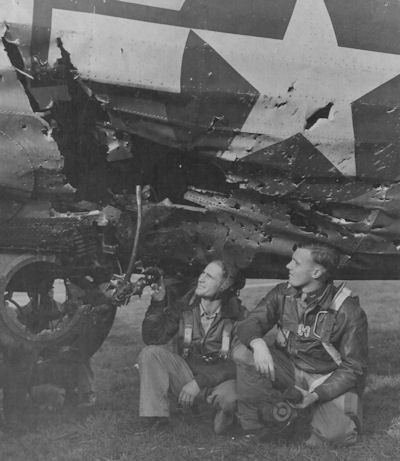
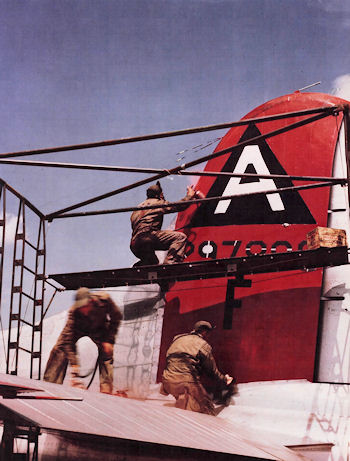
(Left) 91st BG Pilot 1Lt Paul R. McDowell and flight engineer T/Sgt James Hobbs check out the damage by an 88mm flak burst upon return from a mission over Koln, Germany on 15 October 1944. Miraculously, there were no fatalities. (Right) Bassingbourn maintenance personnel apply the 91st BG markings to the old tail of "Wallaroo Mark II," making it the new tail of "Little Miss Mischief."
Since the front half of the aircraft was relatively undamaged, the 441st Sub Depot searched for a replacement for the rear half of the plane. Eventually they located a suitable plane. It was No. 42-31405, “Wallaroo Mark II”, of the 303rd Bomb Group. The undamaged rear half of “Wallaroo Mark II” was brought to Bassingbourn and the two halves merged together to form a flyable plane. What made the rebuilt aircraft unique was the fact that the original “Little Miss Mischief” was silver and “Wallaroo Mark II” was painted olive drab. It made for a strange looking plane. Because of this, the crews nicknamed her “Half and Half.”
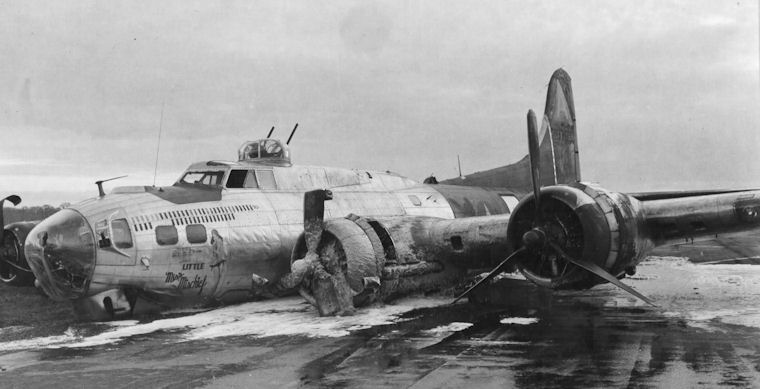
After 40 days in the repair shop, the newly rebuilt "Little Miss Mischief" was flying again. She went on to fly 29 more missions with the 91st Bomb Group. On April 4, 1945 she crashed on takeoff and was salvaged once more.
![]()
2 October 1943
Target: Port Area & Dock Facilities, Emden, Germany
Emden, Germany was the target again, with a repeat mission of the 27 September 1943 effort.. One aircraft aborted: #41-24561 The Duchess 359BS (Lt. Reeder) - The No. 3 engine had been feathered and would not start again. The ship aborted while the Group was forming.
The bombers flew in perfect formation and made an excellent bomb run on the target. The bombs were dropped through overcast skies in close formation on the lead aircraft of the 384th BG(H). This aircraft was a Pathfinder aircraft whose "Mickey" operator made the bomb run with his H2S radar equipment. Parachute flares came out of the lead Combat Wing B-17, but they were not observed as opening. Fifty-seven tons of H.E. M-43 500-lb. G.P. bombs plus 16 bundles of "nickels" (propaganda leaflets) were dropped from 23,500 feet. This was the first time that the 303rd BG(H) dropped leaflets.
The formations were escorted in from the German coast and back out to the coast again by P-47 "Thunderbolt" fighters. All crews agreed that the fighters gave them perfect cover and kept most of the Nazi fighters out of reach of the bombers. Despite this cover, a few did manage to come through the formation and made several head-on attacks before they were chased away by 8th Air Force fighters. While there were many enemy fighters in the air, not more than six came in to make one of the most vigorous attacks yet seen by our crews.
Anti-aircraft gunfire over the target was intense, but not very accurate. Major Mitchell, Lead pilot in #42-29931 "Satan’s Workshop" reported:
"We were flying perfect formation and when we hit the German coast, the P-47s were right there to meet us. They sure looked good, and I might add that if they hadn't been with us we would have had a hell of a tough fight. Anyway, we went on over the target and dropped our bombs in as pretty a pattern as you will ever see. It was really beautiful to watch. Saw lots of Nazi fighters out there, but they were quite a distance away. There were only four that really came in and made a pass at us. I saw them coming, so I told my ball turret gunner [S/Sgt. Clayton R. Bagwell] that I was going to lift up the nose when they came in so he could get a good shot at them. I did - and he let them have it. Two went down through the clouds smoking. All in all, it was a pretty good raid."Sgt Bagwell claimed an FW-190 as a damaged and 1Lt George E. Wright, flying in the tail gunner position, claimed an ME-109 as destroyed.
Maj. Glynn Shumake added, "Could see lots of enemy fighters out to one side of us, but our own fighters kept circling and covering us, so I guess they weren't too eager to move in too close, although about half a dozen did try it."
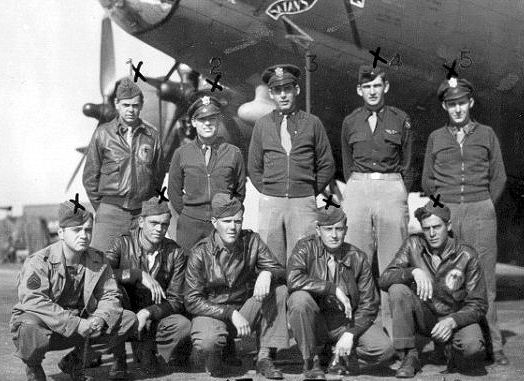
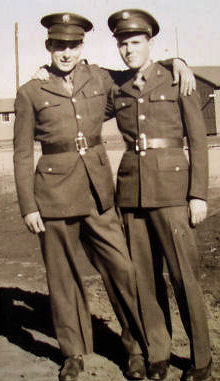
1Lt. Paul S. Tippet pilot of #42-5260 Yardbird II 360BS, was hit by two ME-109s immediately after the formation left the target. The ship peeled off, went down out of control and exploded above the overcast. One parachute was seen coming out of the ship before it went out of sight. All crew members were later confirmed as killed in action. The lost crew members were: 1Lt Paul S. Tippet (P), 2Lt Lewellyn H. Nemitz (CP), 2Lt Edwin E. Mims (N), 1Lt Bernard Rice (B), T/Sgt Oaks H. Smith (E), Sgt Carney C. Rhodes (PHO), T/Sgt. Thomas L. Richardson (R), S/Sgt. Abraham J. Rasch (BT), S/Sgt. Hugh F. Gibney, Jr. (WG), S/Sgt. William R. Greason (WG) and S/Sgt. Jack H. Randall (TG).
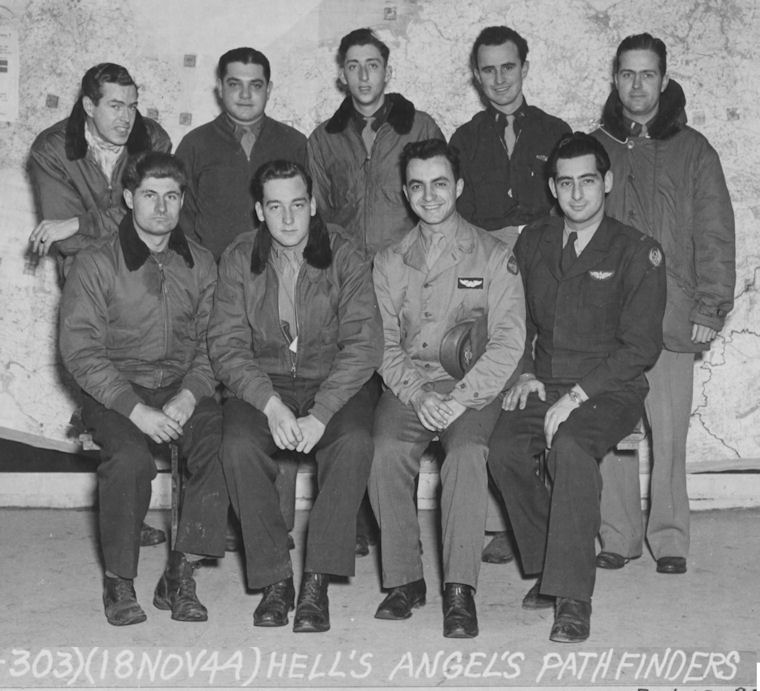
303rd BG "Pathfinder" Navigators – November 18, 1944 – Can you identify anyone?
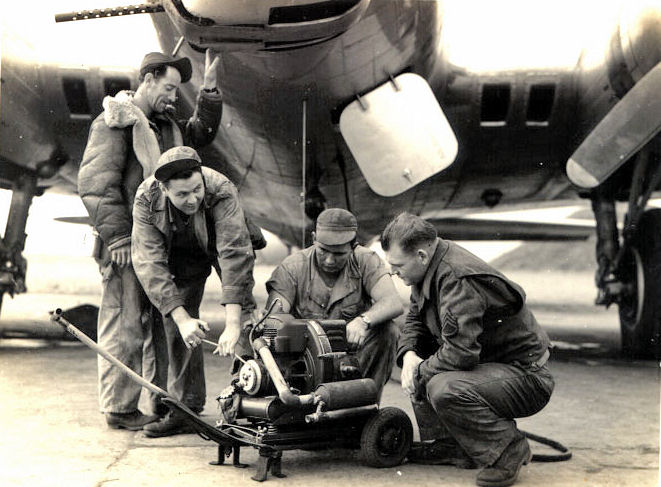
Firing up the Auxiliary Power Plant, better known as the "putt-putt" are four members of the 358th BS
#42-39785 "Thru Hel'en Highwater" Ground Crew. M/Sgt James W. Smith is behind the putt-putt.
The two men on the left are identified as "Gramps" and "Pete."
by George Tibbits, Associated Press
September 14, 2010
 |
It's also where the mostly unskilled workers of a fish-and-timber town first learned the art of assembling aluminum, engines and electronics into sophisticated flying machines.
As the danger of global conflict grew, Boeing opened the factory in 1936 to build the prototype for the B-17 Flying Fortress. Eventually, nearly 13,000 of the bombers would be built, half of them at Plant 2.
Later in the war, it was where Boeing developed the B-29, a revolutionary plane with advanced radios, radars and computer-aided machine guns, that dropped the atom bombs on Hiroshima and Nagasaki.
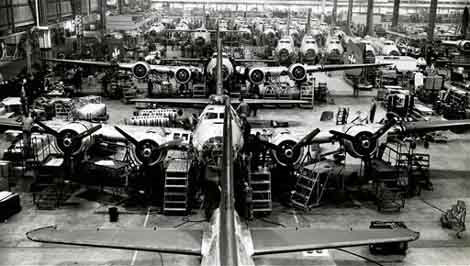 |
Under an agreement with the state and federal governments and Indian tribes, Boeing will tear down the nearly empty factory to restore more than a half-mile of the Duwamish and create nearly 5 acres of wetlands. Demolition should begin this fall, Boeing spokeswoman Kathleen Spicer said.
Plant 2 is about a mile up upriver from Boeing's original Plant 1, a site sold decades ago. The difference between the two was striking, Boeing corporate historian Mike Lombardi says. Plant 1 was a workshop where biplanes were stitched, glued and nailed together. Plant 2 was a modern assembly line, where metal parts fabricated in the back were transformed into aircraft as they inched toward the front doors.
Thousands of people -- at one point nearly half of them women -- worked at the plant during World War II, breaking barriers and requiring Boeing to adopt new ways of treating employees.
Eva Vassar was a wartime shipyard welder before being hired at Plant 2 in 1951 as a riveter and mechanic. "Sometimes I would be the only woman in that area," she said, "but they enjoyed working with me because I carried my weight. I'm not just bragging, but I did the job just as well."
Joe Sutter got a summer job at Plant 2 in 1940 while studying aeronautical engineering at the University of Washington. After the war, he came back to Boeing, where he's known as the "father of the 747" for being the jumbo jet's chief engineer.
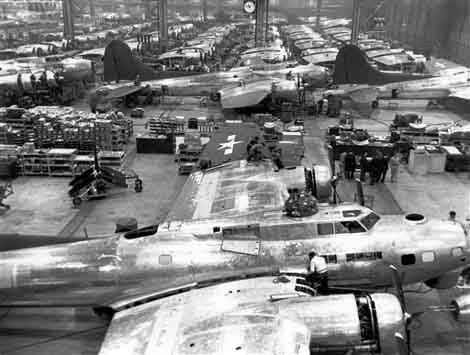 |
Plant 2 was so critical that Boeing camouflaged its roof with faux streets and houses of fabric and plywood, making it nearly vanish into nearby neighborhoods.
Beneath the plant, tunnels led to cafeterias, restrooms and classrooms, innovations to make life easier for workers and keep them close to their jobs.
In the late '40s, Plant 2 was where Boeing developed the B-47, the first large swept-wing jet, and the B-52 bomber, still in service with the Air Force after six decades. In the 1960s it turned out the initial 737, now Boeing's best-selling jetliner.
But the plant was headed toward obsolescence within 15 years after it opened. Though it had expanded from its original 60,000 square feet to more than 1.7 million, it was too small for modern aircraft. And the roof beams were just 35 feet high. That was a problem -- the tail of the prototype B-52 was 48 feet tall. Boeing's temporary fix was to put hinges on the early B-52s' vertical fins, Lombardi said.
Plant 2 was used as a machine shop into the 1980s, but emptied as that work shifted to bigger, more modern facilities. The plant is now overshadowed by Boeing's nearby complexes for military work, research, offices, flight testing and aircraft deliveries.
Parts of old factory are too dangerous to enter. Mark Calkins, head of facilities for the site, says Boeing has been reluctant to sink more money into the building, which leaks, has been damaged by earthquakes and where broken water mains sometimes flood the tunnels.
The huge production bays now store tools, vehicles and surplus office equipment, plus scattered piles of old computers and other castoffs. Boeing also provides temporary space for Museum of Flight volunteers restoring a B-17, a B-29 and a Lockheed Super Constellation airliner.
"I know it's got structural difficulties and it's probably a headache to maintain," Sutter says, but he'd like at least part of Plant 2 preserved to display such historic planes. "It's just sad to see it go."
![]()
by Gary L. Moncur
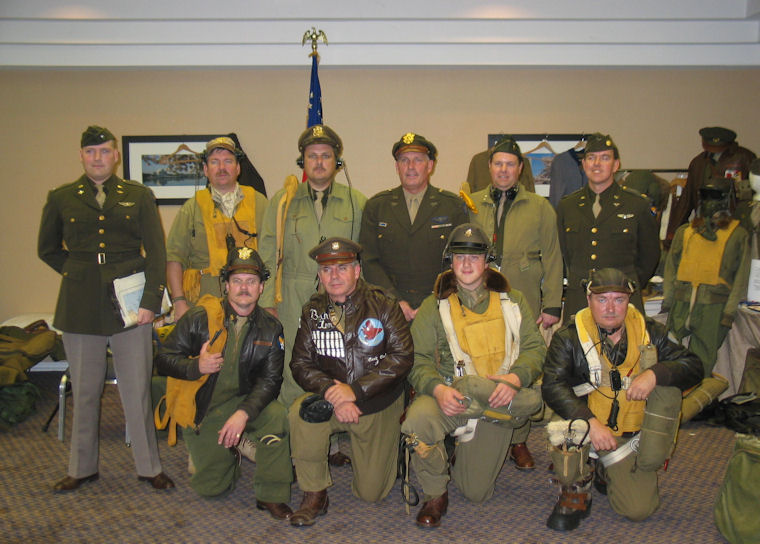
Capital Wing of the Airmen's Preservation Society at the 303rd Bomb Group Association's 2007 Washington DC Reunion
Those who attended the 303rd Bomb Group Association's Grande Finale Reunion in Washington DC in 2007 will recall the wonderful display of WWII uniforms and memorabilia provided by the Airmen's Preservation Society. One of the Society members, Richard Holliday (standing at the left), brought his authentic B-15 jacket to the reunion.
While at the reunion, Richard befriended 303rd Bomb Group veteran Lee Faulkner. Lee is a stand-out at all 303rd reunions, always wearing his hand-painted A-2. Lee agreed to take Richard's B-15 jacket home to Colorado and paint it for him, asking that he be given plenty of time to get it done.
After about 18 months went by, the jacket had not been returned and the owner was becoming concerned. To make it more distressing, Richard had forgotten the name of the veteran who taken his jacket. I was contacted by Richard Holliday in hopes I could help in locating him. I provided the contact information for Lee Faulkner and thought no more about it. After many failed attempts to contact Lee, Richard had given up all hope of getting his jacket back.
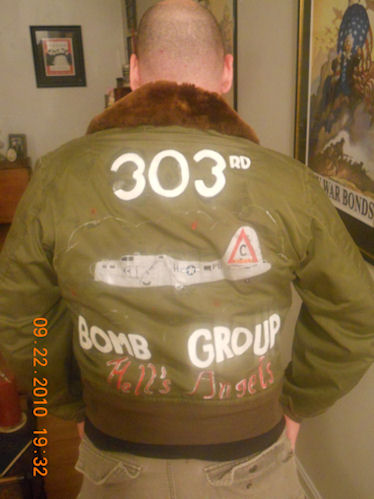
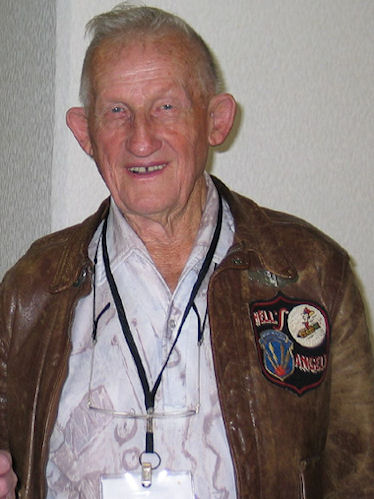
Richard Holliday displays the artwork on his prized B-15 Jacket painted by Lee Faulkner (right)
Fast-forward another 16 months to the July 2010 8th Air Force Historical Society Reunion in Tucson, Arizona. At the 303rd BG Rendezvous Dinner, Susan and I were seated at the same table with Lee Faulkner and his family. Daughter Eleesa mentioned that they had a jacket with them that Lee had received in 2007 to paint. He had completed the work, but had lost the owner's name and address. The family had taken the jacket with them to each reunion following 2007 in hopes of finding the owner. I vaguely recalled once receiving an email from someone looking for their jacket, but no longer had the message. I phoned our son Michael and asked if he could search the old, deleted email on our server for the message. With computer skills far beyond my own, he managed to recover the old, deleted message.
At the reunion's Gala Banquet, I surprised the Faulkner family with the name and phone number of the jacket's owner. Within minutes, Eleesa had phoned Richard and arrangements were made to return the jacket. The chance conversation at the Tucson Reunion made it a very special us, and especially for Richard Holliday and the Faulkner family.
I have just added all known Missing Air Crew Reports for the 303rd Bomb Group's aircrews that were missing in action over enemy territory. They are available to download or view for free. There is now a MACR link on the Navigation Bar on each webpage, or you can go directly to: http://www.303rdbg.com/macr.html Some are quite large, so the download may be slow.

We welcome you to Join us on Facebook,
 Dal Bee Nichols, 87 of Pryor, Oklahoma went home to be with Jesus on September 17, 2010. He was born in Octavia in the Kiamichi Mountains of Leflore County in Southeastern Oklahoma on July 15, 1923, to Dodd Nichols and Alice (Corley) Nichols. He moved to Tulsa and graduated from Central High School, and then attended Oklahoma Baptist University. He met and married the love of his life, Waneta Jordan, who preceded him in death after 61 years of marriage.
Dal Bee Nichols, 87 of Pryor, Oklahoma went home to be with Jesus on September 17, 2010. He was born in Octavia in the Kiamichi Mountains of Leflore County in Southeastern Oklahoma on July 15, 1923, to Dodd Nichols and Alice (Corley) Nichols. He moved to Tulsa and graduated from Central High School, and then attended Oklahoma Baptist University. He met and married the love of his life, Waneta Jordan, who preceded him in death after 61 years of marriage.
He joined the Army Air Force in 1942 and became part of the 8th Air Force and was in combat as a B-17 tail gunner in the 303rd Bomb Group’s Hells Angels stationed in England. He flew 33 missions and was honorably discharged in 1945. He worked in sales for the next 50 years until he officially retired at the age of 83. He also served faithfully as a deacon for over 35 years and was a choir member for over 50 years at First Baptist Churches in Tulsa and Pryor. He served as a Sunday School Department Director and Bible teacher for many years. He was also a Gideon member and officer for over 17 years. He served on the Board of Governance and in the pastoral care program at the Mayes County Medical Center in Pryor, and served on the Pryor Battered Women’s Shelter Board.
Dal found another companion in life and married Avil Cooper in 2005, and she preceded him in death in 2009. Dal is survived by two half-sisters, Mary Grace Moreland and Dolores Young; one son, Grady Lee Nichols and wife, Sandra of Siloam Springs, AR; two daughters, Sharon Nichols of Valparaiso, IN and Elaine Cadion and husband Jerry of Beggs, OK; five grandchildren; eleven greatgrandchildren; son-in-law and daughter-inlaw; Larry and Donna Lees of Pryor, OK and a host of other family and friends. Dal will be so very missed by all who knew and loved him. A Celebration Service will be held at 11:00 a.m. Tuesday – September 21, 2010 at the Hayhurst Funeral Home Chapel in Broken Arrow, OK. Dr. Mike Cox of First Baptist Church-Pryor will officiate.
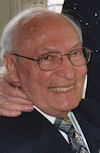 Louis T. Gennaro passed away March 19, 2010. Louie was born in Vineland, NJ May 29, 1917 and lived in NJ the rest of his life. He had to quit school at an early age to help support his family
and after WWII went back to school to finally work his way up to a Masters Degree.
After the war he stayed in the Air Force Reserve reaching the rank of Lt. Col.
and retired from the reserve in 1977.
Louis T. Gennaro passed away March 19, 2010. Louie was born in Vineland, NJ May 29, 1917 and lived in NJ the rest of his life. He had to quit school at an early age to help support his family
and after WWII went back to school to finally work his way up to a Masters Degree.
After the war he stayed in the Air Force Reserve reaching the rank of Lt. Col.
and retired from the reserve in 1977.
He spent over twenty years before and after the war working for the IRS and after retiring spent over ten years working for the State of NJ Tax Department. In later life he worked from home as a CPA.
Louie and his wife Jean were married over 65 years and had six children and numerous grandchildren and great grandchildren. He is survived by Jean.
He loved the Air Force and would have been proud to be buried with his fellow
Patriots at Arlington National Cemetery.
 Norman A. Sampson, 89, Ozark, passed away Tuesday, September 14, 2010 after a short illness. He was born February 5, 1921 to Samuel and Brita ( Engedahl ) Sampson in Buffalo Center, Iowa.
Norman A. Sampson, 89, Ozark, passed away Tuesday, September 14, 2010 after a short illness. He was born February 5, 1921 to Samuel and Brita ( Engedahl ) Sampson in Buffalo Center, Iowa.
He proudly served his country during World War II as a member of the 303rd bomber group "Hells Angels". He performed as a ball turret gunner and later a (B-17) radio operator and successfully completed 25 missions over Germany. Norman was the last surviving member of his crew.
Norman is survived by his wife, Anita P. ( Hazlett ); three children, Connie Fuller, Norma Utne and husband John, Joseph Sampson and wife Michele; four grandchildren, Graham Fuller, Isaiah, Ben and Noah Utne; one great-grandson Gabriel Fuller; brothers, Tillman, Ivan and Donald Sampson; and one sister, Starlene Fields.
Norman has requested no funeral service. A celebration of his life will be held from 1 to 6 p.m., September 25, in the family home. Arrangements and cremation under the direction of Barnes Family Funeral Home.
"Well done good and faithful servant."
 Gareth G. Lee, Ret. USAF Lt. Colonel, of West Deptford, NJ, went to be with the Lord, on Monday morning, September 13, 2010 at the NJ Veterans Memorial Home in Vineland, NJ. He was 88 years of age. Born June 1, 1922 in Loma Linda, CA and raised in Provo, UT, he is the son of the late Edwin R. Lee and Mina (Nee Manchester) Lee.
Gareth G. Lee, Ret. USAF Lt. Colonel, of West Deptford, NJ, went to be with the Lord, on Monday morning, September 13, 2010 at the NJ Veterans Memorial Home in Vineland, NJ. He was 88 years of age. Born June 1, 1922 in Loma Linda, CA and raised in Provo, UT, he is the son of the late Edwin R. Lee and Mina (Nee Manchester) Lee.
Mr. Lee was a WWII Pilot with the Hell’s Angels 358th Bomber Squadron; 303rd Bomb Group; 2nd Air Division in the 8th Air Force. He was Squadron Commander in the Vietnam War and retired out of the Pentagon in 1973 with 30 yrs. of service. He is the husband of the late Doris H. (Nee Monroe) Lee and is the Loving Father of Carol A. Lee-Mooney of TX, Robert E. Lee and his wife Sue of Medford, NJ, Nancy Lee-Brown of NC and James A. Lee of Thorofare, NJ.
He is also survived by his Grandchildren Monica and Nick Atkinson of TX, Gareth Scott Jackson of TX, Paul Daniel Mooney of FL, Darren M. Mooney of FL, Joshua and Robin Lee of FL, Aaron and Abby Lee of FL, Daniel Lee of FL, Abigail Lee of NJ, Elizabeth Lee of FL, Christopher Lee Brown of Hawaii, Justin Kelly Brown of FL, and James Tyler Brown of NC, his Great Grandchildren Jason and Paula Hillis of TX, Stephanie Albury of IL, Melissa Albury of IL, Randall Hillis of TX, Brittany N. Jackson of FL, Christopher Scott Jackson of FL, Darren M. II of TX, Grayson Mooney of FL, Serina Wasllewski of FL, Ayden Eric Throne of NC and his Great Great Granddaughter Audrey Claire Hillis. He is also survived by his many nieces and nephews, friends and other relatives. He is the Grandfather of the late Carl Thomas Mooney.
Relatives and friends are invited to his viewing on Thursday from 7:00-9:00 PM and on Friday from 9:00-10:00 AM at the BRADLEY and STOW FUNERAL HOME, 127 Medford-Mt. Holly Rd., Medford, NJ, (609-953-7600), where a Funeral Service will be held on Friday at 10:00 AM. Interment will follow in the Eglington Cemetery in Clarksboro, NJ.
![]()
Gary, I tip my hat to you. This issue really got to me. It is sensational. Unfortunately, there are so many stories that haven't been written -yet -Keeping the Legacy Alive,Congratulations, Hal Susskind
Thanks for this account of 'Black Thursday.' I was at Chelveston and remember the day as though it was yesterday. It was painful then as it is today.
Charles Shirley
Gary: You must have rolled out of bed early today to get The Molesworth Pilot out this morning. My eyes watered a little as I read the stories and obituaries. The obit for Jack Rencher was interesting but oh how remarkable it could have been if he were telling it himself. Jack's stories of his life were so enlightening and flavored in words only he could speak. He definitely was one of a kind. We will miss him but never forget him.
Al Dussliere
Gary, thank you for keeping me on the list. When I was involved in the 303rd forum years ago, I've met some of the finest men I will ever know. Men who with kindness and even tempers had the courage to relive experiences in their lives that they would probably rather have forgotten. They did so with quiet dignity. Jack Rencher is the epitome of them all. We owe them all a debt of gratitude that can only be repaid by keeping their memories and their history alive. Thanks to your selfless efforts, Gary, we have the venue and inspiration to do just that. Semper Fidelis to all.
Lloyd Grant, Son of the 427th

|